Carlbury
Carlbury is a hamlet in the civil parish of High Coniscliffe in County Durham, in England. It is situated a few miles to the west of Darlington, on the north bank of the River Tees between Piercebridge to the west, and High Coniscliffe to the east. High and Low Carlbury once constituted a slightly larger settlement, but most of the hamlet at Low Carlbury became derelict and was demolished by the late 1940s. A few buildings remain.
| Carlbury | |
|---|---|
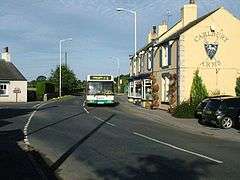 Carlbury Arms | |
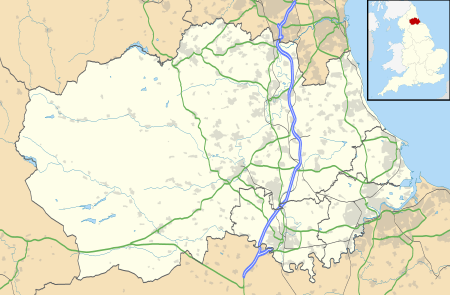 Carlbury Location within County Durham | |
| OS grid reference | NZ215155 |
| District |
|
| Shire county | |
| Region | |
| Country | England |
| Sovereign state | United Kingdom |
| Post town | DARLINGTON |
| Postcode district | DL2 |
| Dialling code | 01325 |
| Police | Durham |
| Fire | County Durham and Darlington |
| Ambulance | North East |
| UK Parliament | |
History
In 1320 Carlbury was given by the widow of Sir John FitzMarmaduke, Sheriff of North Durham, to Sir Thomas Earl of Lancaster and Leicester. After Sir Thomas was executed for treason in 1322, Carlbury went back to the widow's family and thence to the House of Neville.[1]
Carlbury consisted historically of High and Low Carlbury and was included with Summerhouse and Ulnaby in the estate of the Nevilles in their capacity as Earls of Westmorland from 1354 to 1601, being mentioned in a 1553 document. However Charles Neville forfeited it in 1571 for his part in the Rising of the North. Queen Elizabeth I granted it to Ralph Taylboys or Tailboys of Thornton Hall in 1573; it was then left to Thomas Jenison in 1580 and to William Jenison in 1588. Carlbury still belonged to the Jenisons in 1616. The estate later came into the hands of Childers Welbank Childers of York, who sold it to London merchant George Bainbridge who was born in 1740. At that time Carlbury maintained its own roads and its own poor independently of the parish.[2] Workers by the names of Kipling in the 18th century and Cowley in the 19th century are recorded.[3][4]
An old spelling of the name of this area was Kerleburie. Between the 16th and 19th centuries, Carlbury was well-populated with families of numerous surnames.[5] By the 19th century it was a hamlet at the foot of Carlbury Bank, served by the Piercebridge railway station which was on the NER Darlington and Barnard Castle railway (1858–1964). In the hamlet was the Railway Inn, the fairly large Bridge House, and Carlbury's own bridge over Dyance Beck, which in turn powered Carlbury Mill. The mill burned down at night in 1889, discovered by a hapless cyclist who, despite great effort by telegraph from Piercebridge and then by pedalling to Darlington, was unable to raise the fire brigade in time to save the mill. The hamlet was mostly derelict by 1939, and all but a few buildings were demolished after World War II in the 1940s before the A67 was built.[6]
Carlbury Hill and Carlbury Hall
During the Civil War on 1 December 1642 a contingent of Royalists, led by the Earl of Newcastle and travelling south along Dere Street, met a group of Parliamentarians, led by Captain Hotham and travelling north, in a dispute over the bridge at Piercebridge. The Royalists won the day by erecting a battery on Carlbury Hill, which higher position had an advantage over the opposition's battery on the other side of the river. Cannonballs and human bones from this battleground have been found on the banks of the river.[7] On 9 December 1672, Jane Hill fell from the hill and died four days afterwards.[5]
In 1875 on that same Carlbury Hill, architect John Ross built Carlbury Hall in Scots baronial style for National Provincial Bank manager Thomas McLachlan; McLachlan is said to have chosen the site where the view of the River Tees would remind him of Scotland.[6] By 1905 Carlbury Hall was in the hands of James Backhouse Dale (born 1855), a company director of Hordern Collieries Ltd,[8][9] and between 1909 and 1929 it was owned by John Henry Pease, a member of Cleveland Naturalists' Field Club.[10][11][12] In 2003 it sold for £535,000.[13]
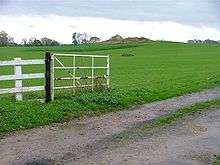
Archaeology
Smotherlaw Barrow is a scheduled monument which was thought to be the site of a castle in 1902, although by 1992 it was understood to be an elongated mound without a ditch, reduced by ploughing and probably a Bronze Age burial mound.[14][15] Mortaria dated around 170–180 AD with painted inscriptions have been found in Carlbury Vale west, and they could be associated with Piercebridge Roman Fort.[16]
Carlbury today
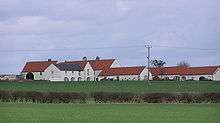
In 2005–2006, Carlbury still had 3.5 hectares of ancient woodland, classified as a Site of Nature Conservation Importance and a wildlife corridor.[17] Today High Carlbury is Carlbury Farm, and the remainder of Low Carlbury is next to the A67 road where there is Carlbury Hall. For a short time in the early 21st century this was a nursing home on Carlbury Hill.[18] Also on the A67 is the Carlbury Arms which is listed by CAMRA and has a pudding club,[19][20] and the Carlbury milestone which is Grade II listed but said to be in poor condition.[21] However, in 2005 Darlington Council saw fit to upgrade the bus shelters at the Carlbury Arms and Carlbury Hall stops.[22] Carlbury Garden Centre is north of the Carlbury Arms, on Station Road.[23] Between the milestone and the river there is a field and a little bridge over stone channels where the mill race once was;[6] Carlbury Bridge is now a Grade II listed building.[24] The hamlet is on the Piercebridge Circular Walk route.[25]
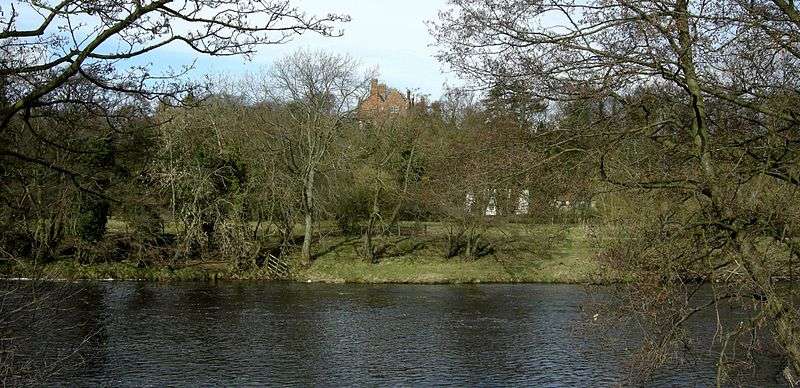
References
- Grindey, Catherine; Jecock, Marcus; Oswald, Al (2008). "Research department report series no.13-2008" (PDF). Ulnaby, Darlington: an archaeological survey and investigation of the deserted medieval village: ISSN 1749-8775. English Heritage. pp. 6, 13. Retrieved 13 March 2010.
- Surtees, Robert (1823). Carlbury, in 'Parish of Conscliffe', The History and Antiquities of the County Palatine of Durham: volume 3: Stockton and Darlington wards. Institute of Historical Research. pp. 378–384. Retrieved 13 March 2010.
- Naylor, Scott (2000). "Rootsweb". Genealogy data. Retrieved 13 March 2010.
- "Roots chat.com". Topic: Joseph Burnside, Cockerton. 2009. Retrieved 13 March 2010.
- Wood, Herbert M. (ed.). "Internet Archive". Registers of Conscliffe, Durham: Baptisms and Marriages 1590–1812; Burials 1591–1812. Retrieved 14 March 2010.
- Lloyd, Chris (28 October 2009). "The Northern Echo". Carlbury: a lost hamlet. Archived from the original on 28 September 2012. Retrieved 13 March 2010.
- Wooler (1905). "Internet Archive". Royal Canadian Institute of the Society of Antiquaries of Newcastle Upon Tyne, 3rd Series, Vol.1. R. Simpson & Sons. pp. 130–131. Retrieved 14 March 2010.
- "Durham Mining Museum". Horden Collieries Ltd., 1905. 30 November 2009. Retrieved 13 March 2010.
- "Internet Archive". "The descendants of John Backhouse, yeoman, of Moss Side, near Yealand Redman, Lancashire, 929.2 Bl27f v.l 1605491. Retrieved 13 March 2010.
- "The National Archives". Herefordshire Record Office: Snead Cox Papers, 21 series, J38/A/18 10 November 1909; 14 January 1893. 2010. Retrieved 13 March 2010.
- "Cambridgeshire County Council". Archives catalogue. CCC. 2010. Retrieved 13 March 2010.
- Jackson, Ernest W. (1925). "Cleveland Naturalists' Field Club" (PDF). Record of Proceedings 1920–25: Members' list. Retrieved 13 March 2010.
- "Zoopla!". DL2 home values. 2010. Retrieved 13 March 2010.
- "Piercebridge". Gatehouse Gazeteer. Retrieved 26 July 2019.
- "Darlington Borough Council scheduled monuments audit 2009" (PDF). Smotherlaw Barrow. DBC. March–June 2009. Archived from the original (PDF) on 16 July 2011. Retrieved 13 March 2010.
- Hartley, Kay. "Part 2: The mortaria" (PDF). Mortaria stamps. Retrieved 13 March 2010.
- "Darlington Borough Council: local development framework" (PDF). Darlington annual monitoring report 2005-06. Planning Services, DBC. 22 December 2006. p. 76. Archived from the original (PDF) on 16 July 2011. Retrieved 13 March 2010.
- "Privatehealthcare.co.uk". Carlbury Hall Nursing Home. 2005–2010. Archived from the original on 5 May 2013. Retrieved 13 March 2010.
- "Campaign for Real Ale: County Durham Pub Guide". Carlbury Arms. 2010. Archived from the original on 23 March 2010. Retrieved 13 March 2010.
- North, John (16 July 2009). "The Northern Echo". Scotch missed. Archived from the original on 7 April 2014. Retrieved 15 March 2010.
- Lloyd, Chris (27 October 2009). "The Northern Echo". Existence proved of the yeti of mileys. Archived from the original on 28 September 2012. Retrieved 13 March 2010.
- Buxton, John (28 April 2005). "Darlington Council, Environment Scrutiny Committee" (PDF). Darlington's bus stop network improvements programme. DCC. Archived from the original (PDF) on 30 September 2011. Retrieved 13 March 2010.
- "Carlbury Garden Centre". Contact page. 2010. Archived from the original on 19 December 2009. Retrieved 13 March 2010.
- "Piercebridge Conservation Area, character appraisal" (PDF). Carlbury Bridge. Darlington Borough Council. January 2006. p. 15. Archived from the original (PDF) on 7 November 2007. Retrieved 13 March 2010.
- "Walk the Darlington Way" (PDF). Piercebridge Circular. Darlington Borough Council. 2009. Archived from the original (PDF) on 16 July 2011. Retrieved 13 March 2010.
External links
| Wikimedia Commons has media related to Carlbury. |